I apologize for the delay in posting…there were some problems on the server side. Thanks for your patience!
I’ve been thinking a lot about traditional wired glass recently. It may seem like old news, since the International Building Code changes affecting the impact-resistance of glass began a decade ago, but given the dangers of the existing wired glass in schools and other buildings, it’s a subject that needs to be addressed. Today’s post will begin a series of posts relative to glass. Since this is at the outer edges of my area of expertise, I’ll be bringing in a lot of other resources to help us all improve our knowledge of the current codes, understand why impact-resistance is important, and learn what we can do to address the hazards of existing glass.
Lately I’ve been seeing traditional wired glass improperly used EVERYWHERE. I can’t help but wonder if that would change if everyone really understood the danger associated with its use. When I say “traditional wired glass,” I am referring to wired glass which does not provide the impact resistance required by current codes. Many people are under the impression that traditional wired glass is stronger, or provides more security. In fact, it breaks much more easily than other types of glass. And once it breaks, it can cause severe, life-threatening injuries. There is wired glass on the market today which meets the current code requirements for impact-resistance, but the vast majority of wired glass installed in existing buildings is not impact-resistant.
Here’s a short video showing traditional wired glass being tested for impact resistance. You can imagine the damage it would cause if it was broken by a person.
Since the school shootings in Newtown, Connecticut, there has been a lot of discussion about how to make schools safer and more secure. Glass in the doors and first-floor windows is one of the items in question, because this glass can have an effect on building access. Traditional wired glass has been installed in some of these locations, in a misplaced attempt at providing additional security. In fact, I saw a photo of an exterior door opening at Sandy Hook School (not the door which was used by the gunman), and the pair of doors and adjacent sidelites were all glazed with traditional wired glass.
Watch this video from CBS News that describes the dangers associated with traditional wired glass:
Many of you know that I have 3 young children…very active, rambunctious children. I cringe at the sight of traditional wired glass, especially in locations where children are present or where impact is likely (athletic facilities are particularly scary). On our recent vacation, the condominium had a borrowed lite with wired glass between the bedroom and the exterior walkway. There was NO jumping on the bed during that trip!
I recently did a walk-through of one of my own projects (I wrote the hardware specification) at a university. The brand new doors had traditional wired glass – no impact resistance. I didn’t specify the doors or glass, but I was shocked to see this glass supplied, when our code prohibits its use in hazardous locations – including doors.
At the same university, there is a renovation project underway on buildings designed by the famous architect, Walter Gropius. The university requires the buildings to remain as-is, in keeping with the original design. That includes the “chicken-wire” glass that is installed in every exterior entrance and all of the stairwells.
I saw this storefront with traditional wired glass in all the lites (and ended up with a parking ticket while taking a photo). I can’t help but imagine a wobbly young bike rider or roller blader falling through this glass, which could be life-threatening.
Have you seen any traditional wired glass lately? Do you know how to tell if glass is impact-resistant or not? Stay tuned for my next post (read it here)!
You need to login or register to bookmark/favorite this content.

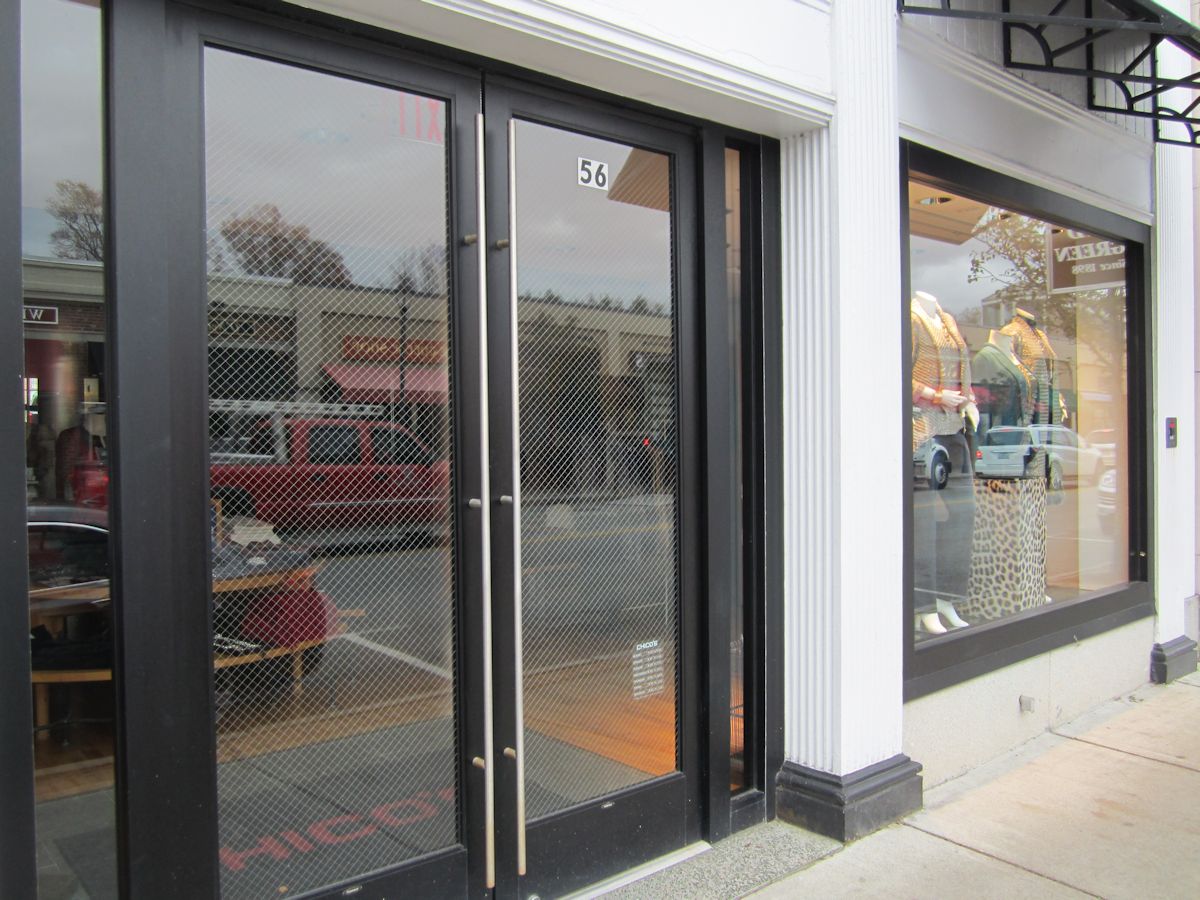
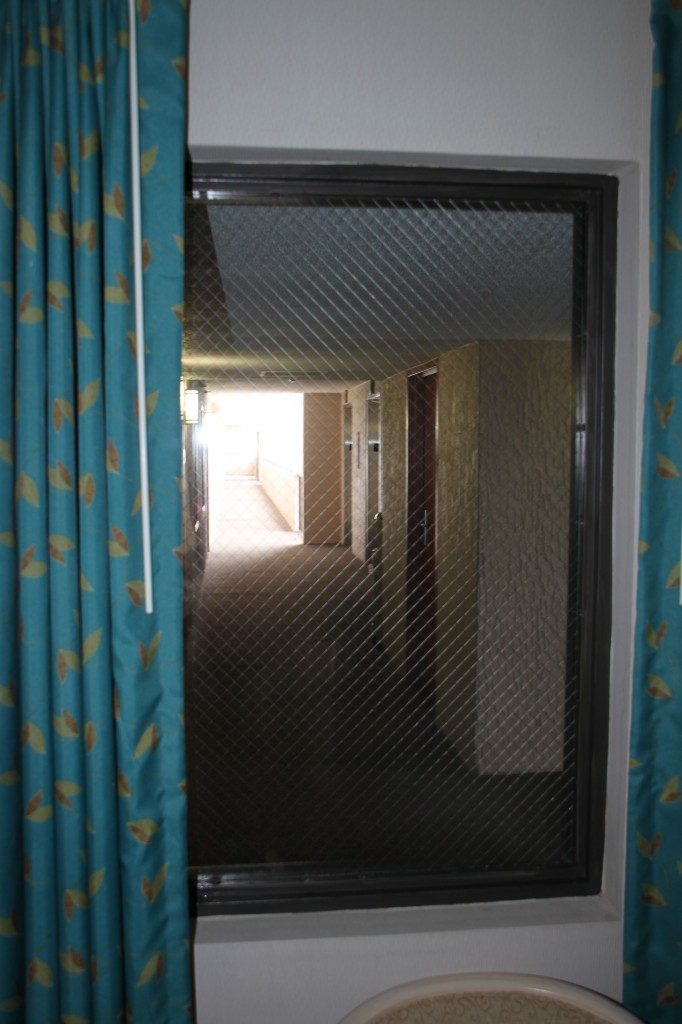
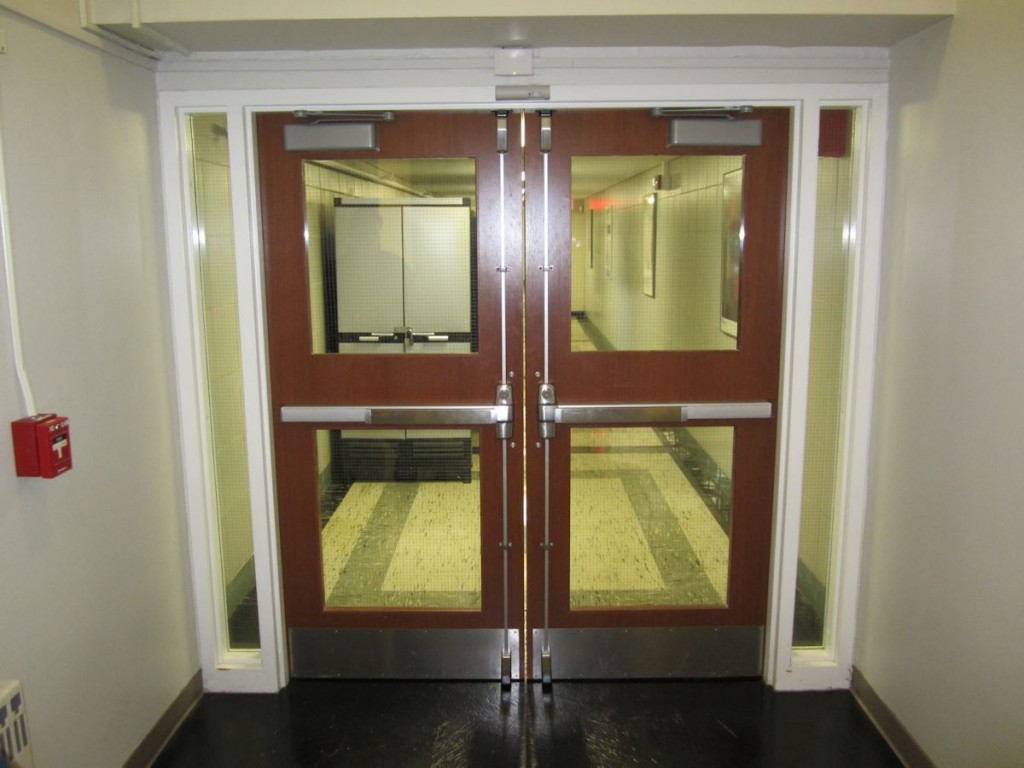
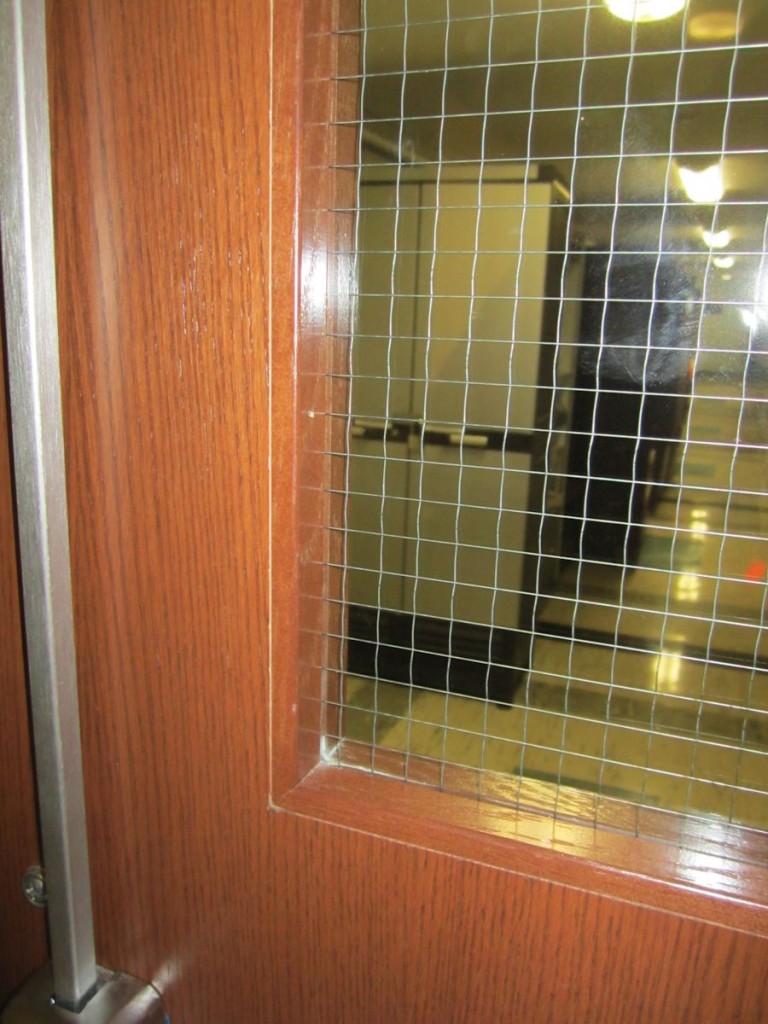
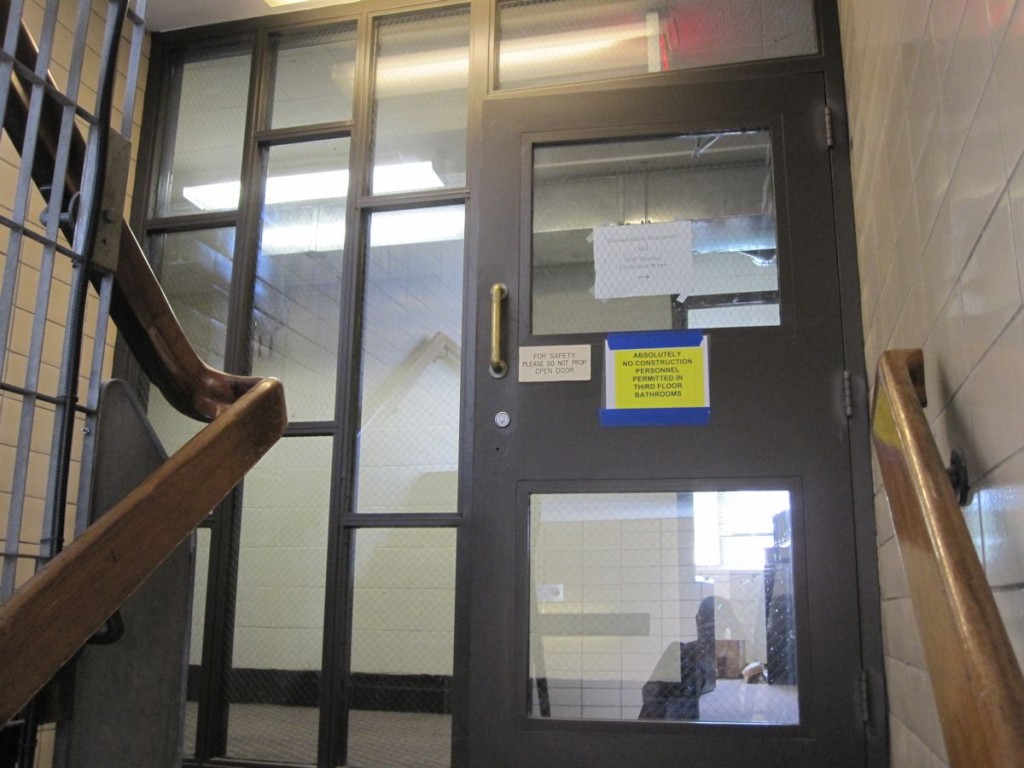
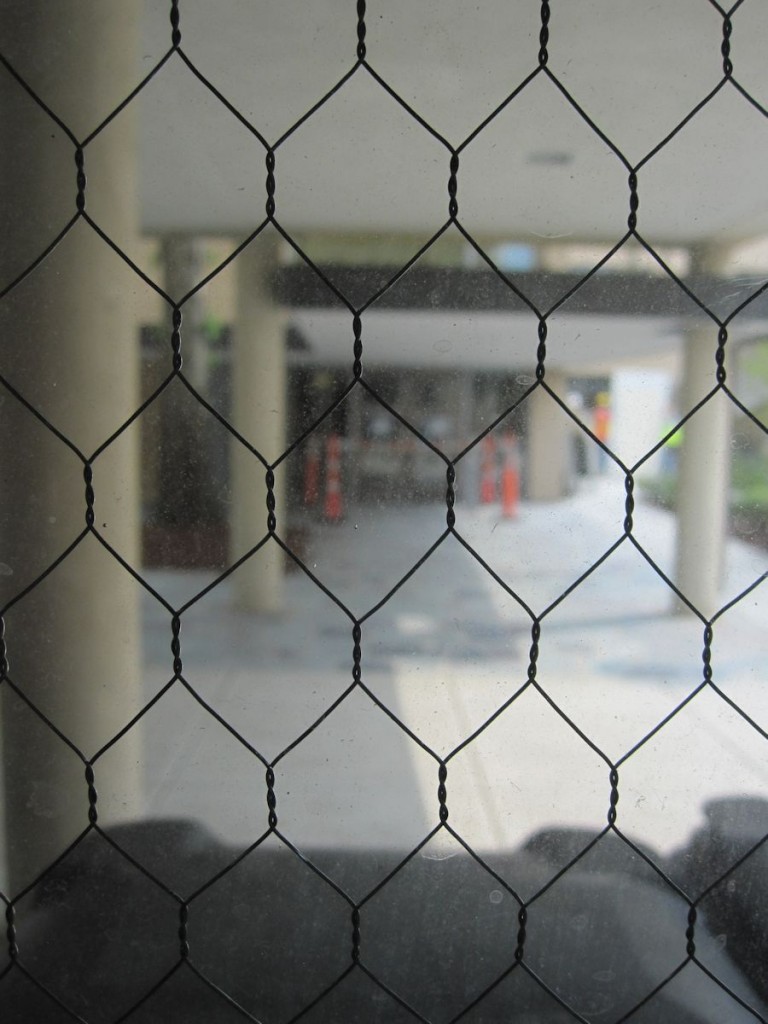





Hello Lori, Great to hear about this topic. I also have two younger ones, and am always concerned by the wire glass in their schools. All of the school knows that I am constantly evaluating the applications and conditions of the doors in our schools here in our little area of the world. Some are starting to listen and realize how long this myth has gone on.
Compare the cost of impact rated glass to a lawsuit and that usually gets some attention. This is a category that can be discussed weekly on your blog just because of the lack of knowledge and the fear of change that is prevalent. Check the mental health rooms (in schools) with glass, that will put a chill thru your spine.
Just keep spreading the news….
The university who wants to keep the building “as-is”…do they really want to keep items that are dangerous, hazardous, or no longer code compliant? What if there is asbestos in the floor tiles, or lead in the paint? Are those things okay to keep “as-is”. The wire glass is a dangerous, hazardous material as far as I’m concerned.
Regarding the news report: who in their right mind would install a borrowed light in a gym behind a basketball hoop? That has less to do with the glass and more do to with design.
I agree that GPW (Georgian Polished Wire) glass is unsafe. However, when I was in door & hardware sales, this type of glass was code compliant for any U/L fire rated door or lite. I had been requested on several projects to use a clear glass, as owners found the wire glass unsightly. The only option at the time was ceramic fire rated glass and the cost difference was astronomical, compare $12 to $150 psf (from memory).
There are many many more clear, safe options now.
Lori, thanks so much for helping spread the word about the dangers of wired glass. Mr. Abel and I struggled mightily against the wired glass cartel to bring about changes in the industry. Changing the IBC was only the first step, and that was a big one…took us three years to undo all the misinformation and penetrate the cartel’s heavy-handed tactics.
I’m proud that Oregon became the first state in the nation to ban the use of wired glass in hazardous locations, and my local school district in Eugene, Oregon, took it one step further and replaced or retrofitted all the existing wired glass in its older schools. Under our new code, any existing wired glass that becomes damaged must be replaced with acceptable fire-rated impact-resistant glazing. And one of your posters is correct, after one or two injuries it became clear that it was more cost-effective to change out the old wired glass before it broke than to pay out on a settlement. Most importantly, however, our school district valued the safety of its children over the cost savings of cheap wired glass.
The wired glass cartel, comprised of foreign manufacturers, was able to effectively prevent the expansion of other safety glazing because they manufacture this stuff on the cheap. They used the U.S. as a dumping ground because the UK would not let them sell the cheap stuff in their country; the UK required a film to be inserted in the wired glass to provide the impact resistance that everyone expects from safety glazing. The other wired glass manufacturers were located in Japan and had the same objective: making money without regard to human safety.
Unfortunately, we still have a lot of education to do. I work for a federal agency now, and we provide loans and grants to businesses, individuals and communities. On a tour of a recent hospital expansion that we provided funding for, I noticed wired glass in the waiting room and in some other locations. You can imagine my horror to see that glass in a waiting room of all places where families with children are present. I immediately took the project manager aside and asked if this was newer, impact-resistant wired glass. His answer was that it was some old glass they had laying around in the shop. I gave him 48 hours to have the glass removed, sent him a copy of the Oregon State Building Codes on the use of wired glass and instructed him to contact the architect and provide him with the same.
Cost should never be the overriding factor where safety is concerned, and with the changes in the International Building Code the United States has seen an expansion in U.S.-made fire rated glazing that is now produced at a competitive market rate. We are not only creating jobs for American workers, but we are also ensuring the health and safety of our citizens.
If any of your readers see wired glass (and, you’re right, it’s EVERYWHERE), ask to speak to the building manager and inform them of the dangers of wired glass. Contact your local building official and ask whether your state has adopted the newer IBC standards for wired glass. Make a fuss. Be proactive. Write letters to the editor. Contact your school district and ask about their applications of wired glass. And if you ever see wired glass on an exterior door, let the building owner know that is an illegal application under any code because wired glass was never allowed to be installed on exterior doors.
It takes a whole village to raise a child, and it takes a whole nation to be vigilant about product safety.
Vicki Walker
Retired Oregon State Senator
Thank goodness that the codes have identified wired glass as a potential hazard and have been changed to use safer products in it’s place. The term contributory negligence sometimes rears it’s ugly head when we examine the circumstances surrounding these sad stories. On balance, a door with a light kit may prevent many injuries and accidents due to being able to see what is on the other side of the door. Lets agree that we need to always think of safety when doing our jobs, as professional hardware people and as parents and citizens in our community. I always fear the result of someone inserting a stick in the outside handle trim of pairs of exit doors, potentially resulting in the exit unusable in case of an emergency.
Agreed. It’s our responsibility to do what we can.
Lori, Thank you for the coverage of this continuing public safety risk. I worked on the wired glass code change before the CPSC and then the code bodies since 1992. Once Greg Abel’s son was injured and he worked with Senator Walker to bring attention to the serious public safety hazards, the code bodies acted and changes were made. I now teach building design professionals and code enforcers about fire and safety glazing code requirements, and continue to see that many are still confused about the dangers of wired glass. I have been retarined as an expert and testified at trial about the hazards of wired glass and its misuse under the codes. The injuries are real and continue to occur.
Today, I encourage all building owners to conduct a survey of existing wired glass installations, and start a replacement program to address the safety risks. Building owners may choose to replace wired glass or engage a certified safety film installer to apply a labeled safety film in the field that has both been fire and impact tested to meet code requirements. With a thorough fire and safety glazing assessment and selection of appropriate replacement products, the cost is affordable, and well worth the expense to protect building occupants from serious injury.
Kate Steel
Steel Consulting Services
Wired glass has been the cause of many injuries and though it has been banned in the United States, there are still countless injuries due to wired glass in Canada. This needs to be stopped. For more information on alternatives to wired glass see http://www.glassopolis.com
Wired glass may be “banned” in the U.S. but is still available for purchase and so continues to be used by anyone who is either ignorant to the risks inherent in it’s use or simply feel like it is worth the risk. The scary truth about wire glass is that it doesn’t even have to be broken to pose a risk. The tiny hairlike shards this glass consists of become fortified in the areas where the glass is surrounding the wire, which during manufacturing becomes red hot along with the melted glass and make the glass adjacent to the wires fuse with the metal . And when the glass is broken these tens of thousands of shards can become embedded by the thousands in and under the skin of anyone so much as making contact with even the unbroken but sharp edges of an uninstalled or unprotected pane of wire glass. Stary as far away from this stuff as you can. I made the mistake of lifting a pane of unframed wire glass without the benefit of gloves and have been suffering ever since, The longer the glass (mine was about the size of the tiniest Lego) remains embedded in the skin the further it migrates and can impair function of joints, eyes and even internal organs for the rest of your shortened life span. Stay away from Wire Glass.